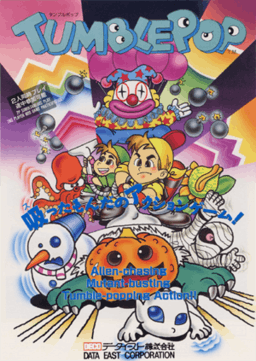Tumblepop
| Tumblepop | |
|---|---|
|
Japanese arcade flyer of Tumblepop. | |
| Developer(s) |
Data East Nintendo |
| Publisher(s) | Data East Later, Nintendo (3DS Only Published) |
| Platform(s) | Arcade, Game Boy, 3DS Virtual Console |
| Release date(s) |
Arcade Game Boy 3DS Virtual Console |
| Genre(s) | Action |
| Mode(s) | 1-2 players simultaneously |
| Cabinet | Upright |
| Display |
Raster, Horizontal orientation 319 x 240 pixels |
Tumblepop (タンブル・ポップ) is an arcade game by Data East released in 1991. It is considered a cult classic, and was later ported to the Nintendo Game Boy.
Gameplay
The game involves one or two ghost-busters who can suck monsters, ghosts, aliens and various other oddball characters into vacuum-cleaner-like devices and spit them back as bouncing/rolling balls. Expelled enemies function as projectiles that can damage and kill other opponents on the screen when colliding with them. The game's looks are reminiscent of Pang. Throughout the game, the player/s can collect letters of the alphabet found in randomly appearing bubbles in order to gradually spell the word "TUMBLEPOP", the progress of which is permanently displayed at the bottom of the screen. When completed, players are transported to a bonus level which gives them the opportunity to obtain higher scores and an extra life, although this level is strictly timed. The word goes back to default after completion.
In the original arcade version, the protagonists work their way through stages set in different parts of the world, each with their own enemies and at least one boss, as listed below:
- Moscow, which is a circus-like stage, enemies being clowns, invisible conjurers, fire spitters; the boss is a giant clown held by balloons who juggles with bombs.
- Egypt: near the pyramids in the desert, the enemies include fire spitters and mummies; the boss is a giant genie appeared from a lamp who spits fireballs.
- Paris: near the Arch of Triumph, all the enemies are robots; the boss is a giant flying robot that sends out flying hands.
- New York City: near the Statue of Liberty and the World Trade Center, the enemies are pumpkin-headed zombies and octopuses; the boss is a giant octopus who appears from the sea.
- Rio de Janeiro: near the Statue of Christ the Redeemer: with several fire monsters; the boss is a dragon made out of fire.
- Antarctica: populated by snowmen, snowmen armed with shovels, and hairy monsters; the boss is a giant snowman wearing a bucket on its head.
- Australia; it has carnivorous plants, cavemen and snowmen made out of mud; the boss is a giant two-headed carnivorous plant.
- Japan: near Mount Fuji with yureis, kappas and skeletons; the boss is a giant pile of daruma dolls.
- Space: Greys, spacemen with blaster guns. The boss is a flying robot that looks like the Flatwoods monster.
- Moon: all the bosses from the previous worlds must be fought again. The final boss is a cyborg mad scientist controlling a giant robot.
The player/s has to complete every level within a specific period of time before exceeding an invisible timer. If the players do not manage to eliminate all the monsters in time, a Dracula-like beast appears and approaches them with a sinister laugh. If the beast manages to touch a player before he/she eliminates all the monsters, the player suffers an instant loss of a life. This also counts in the Boss levels.
Version differences
The Game Boy version incorporates a world map that doesn't resemble Earth; levels are contained in different cities on that map that the player can walk between (similar to the style of the world map in Commander Keen). If a city proves too hard, it is also possible to drop out of it and come back later (though not if the Game Boy is turned off, due to a password saving system). The enemies in a given city approximately correspond to those in an area in the arcade version, though there will not necessarily be any link between the cities of the world and the cities of Tumblepop. In addition, the Game Boy version incorporates a shop in which players can spend their points to buy power-ups.
Cultural references
- The fire breathers are modeled after Karnov, the star of a Data East arcade game by the same title.
- The cavemen and the Tyrant Triffids are from Joe and Mac, another Data East arcade game which stars two cavemen.
- The gray spacemen are based on Chelnov from the Data East arcade game Atomic Runner Chelnov.
- An automatic letter "E" is received in the first round of the Brazil stage in the arcade version, as part of letters spelling "SENNA"
References
- ↑ Complete Game Boy Games List Nintendo. Retrieved on 2009-05-01
External links
- Tumblepop at the Killer List of Videogames
- Tumblepop at arcade-history
- Game Boy version at MobyGames
